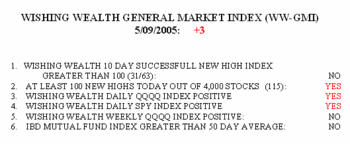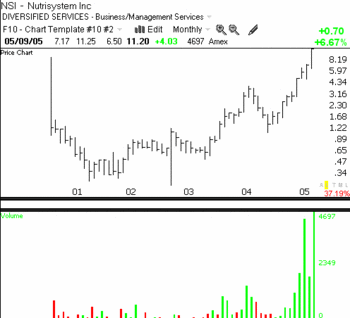The market continued to strengthen today and the Daily QQQQ index turned positive. Please note that this indicator can go back and forth before the trend is solidified. I am very pleased by the market’s action. Many of the growth stocks I follow broke out today. I have sold all of my puts and have taken some long positions. 
The bottom line is that the odds have shifted towards owning stocks. And many of the stocks I am watching have moved up. Among the stocks I like are: IVGN, SHLD, MHS, CVD, MW, SWN, HANS, TOL, ORCT. These are not recommendations, although I do own some of them. These stocks are all trading near their highs and such stocks can reverse direction quickly. I always place a sell stop order immediately after my purchase goes through. That way I can sleep nights. I also make small initial buys and wait to see if the stock moves up as I expected. I never average down (buy more as the stock falls) and I do not average up too quickly. I am not looking for a stocks that will climb for a day or two. I am hoping to ride a stock up for weeks or months. I am buying stocks that are behaving well and that seem to be earning money.
Another tactic that I use is to buy an ETF (exchange traded fund) that reflects a market index. There are many benefits of ETF’s, compared to mutual funds. Perhaps the biggest is that ETF’s can be traded like stocks in the middle of the day. A mutual fund can only be bought or sold at the end of the day after the market is closed and the fund’s assets are tallied. Thus, with an ETF, you can get in or out quickly if the market should become volatile or violent. The fees of an ETF are cheap and if you use a deep discount broker the transaction costs are small.
So, if I think the S&P 500 is turning, I can buy the SPY which reflects this index. The nice thing about buying the SPY is if the S&P 500 goes up SPY will go up. How many times have you seen the market go up and your stock doesn’t move or falls! At least I know that will not happen with the SPY.
One big mistake to avoid is to buy for technical reasons and then when the stock fails to rise or declines, to hang onto it for fundamental reasons– because good earnings are expected to come out or there is a really great product or the market is strong. If I buy because of good price action I must sell because of bad price action–no excuses or rationalizations. I have violated this rule many times, and paid the penalty.
Sometimes my biggest winners have been stocks that keep coming to my attention over and over. One such stock is NSI (click on chart to enlarge), a diet and fitness firm.  NSI has gone from a low of $1.09 last August to a close today of $11.20. The monthly volume is at an all time high since it came public in 2001. Its revenue is increasing at a fast rate and there sure are a lot of obese baby-boomers who are looking for the fountain of thinness. I don’t like to buy cheap stocks like this but I sure am going to watch it. There is a planned stock offering and this could be affecting the stock’s price. (I remember reading that it is legal for underwriters to stabilize a stock during an offering–sounds like manipulation to me.)———————————————————————
NSI has gone from a low of $1.09 last August to a close today of $11.20. The monthly volume is at an all time high since it came public in 2001. Its revenue is increasing at a fast rate and there sure are a lot of obese baby-boomers who are looking for the fountain of thinness. I don’t like to buy cheap stocks like this but I sure am going to watch it. There is a planned stock offering and this could be affecting the stock’s price. (I remember reading that it is legal for underwriters to stabilize a stock during an offering–sounds like manipulation to me.)———————————————————————
Every morning I want to know if the stock futures are indicating a strong or weak market opening. I found a web site called, morning call, that tells me if the futures are trading above or below fair value. Above fair value indicates buying pressure that could lead to an up open, below fair value, to a down open. Hope you enjoy this site as much as I do.
Send me your feedback at silentknight@wishingwealthblog.com.
Please remember that the stock market is a risky place, especially now. I am not providing recommendations for you to follow. My goal is to share tools and methods that I have used over the past 40 years of trading, so that you may learn from them and adapt them to your trading style and needs. While I do my best, I do not guarantee the accuracy of any statistics computed or any resources linked to my blog. Please consult with your financial adviser and a mental health practitioner before you enter the stock market, and please do not take unaffordable risks in the current market environment. See the About section for more statements designed to protect you (and me) as you navigate this market. Past performance does not guarantee future results, but I would rather learn from a former winner than a loser.